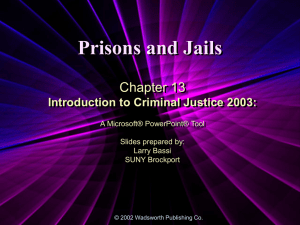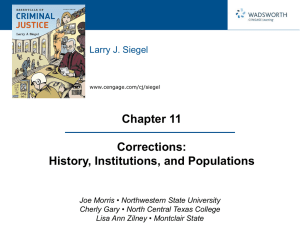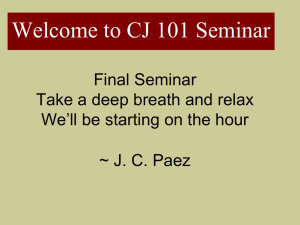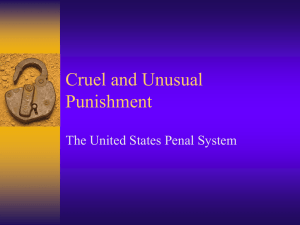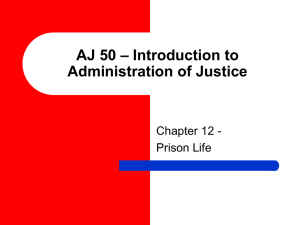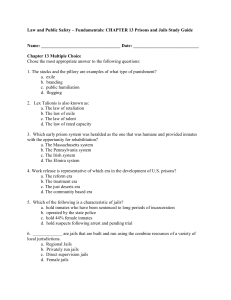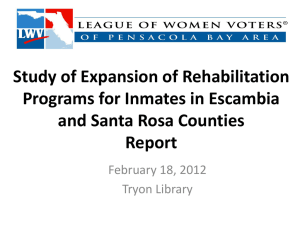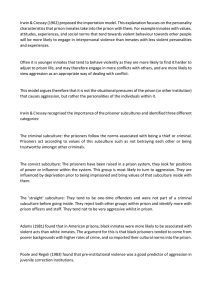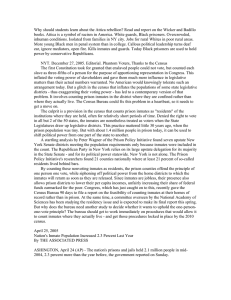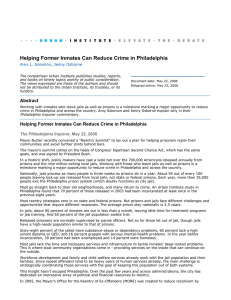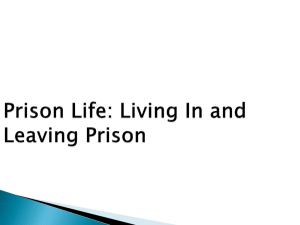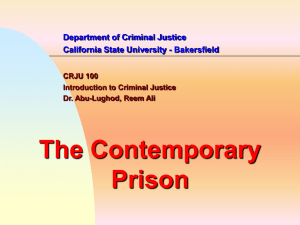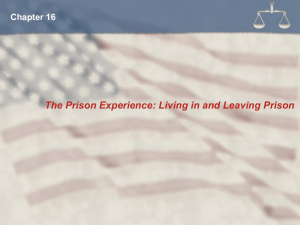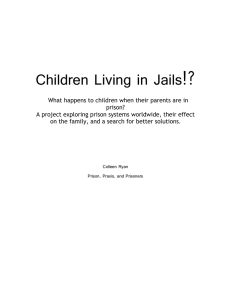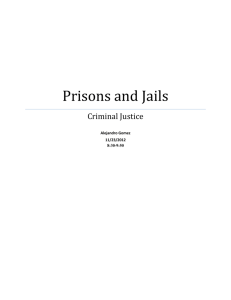Corrections WrkSht for Jails and Prisons
advertisement
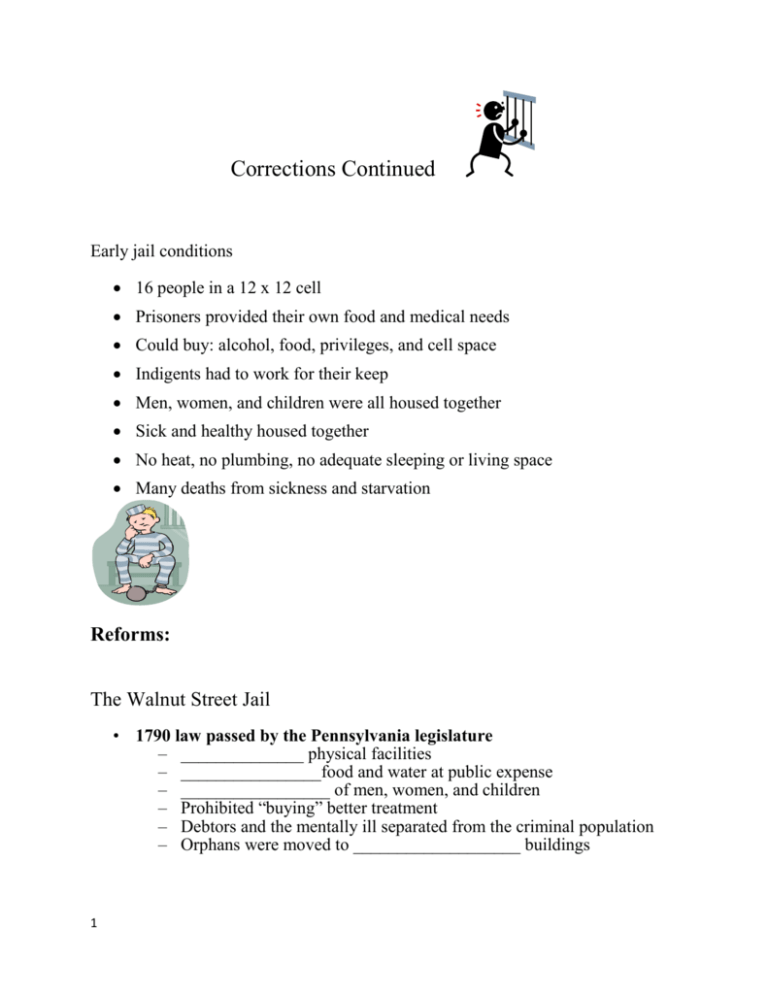
Corrections Continued Early jail conditions 16 people in a 12 x 12 cell Prisoners provided their own food and medical needs Could buy: alcohol, food, privileges, and cell space Indigents had to work for their keep Men, women, and children were all housed together Sick and healthy housed together No heat, no plumbing, no adequate sleeping or living space Many deaths from sickness and starvation Reforms: The Walnut Street Jail • 1790 law passed by the Pennsylvania legislature – ______________ physical facilities – ________________food and water at public expense – _________________ of men, women, and children – Prohibited “buying” better treatment – Debtors and the mentally ill separated from the criminal population – Orphans were moved to ___________________ buildings 1 Prison life at The Walnut Street Prison • • • • • Prisoners __________________, but were paid for labor Earned early release for _______________behavior Attempted to _______________prisoners Became overcrowded Conditions deteriorated and costs skyrocketed Eastern State Penitentiary • • • • • Built in _________________ Cost $500,000 to house 250 prisoners Most expensive building in the new world First in the country to have flushing toilets and hot-air heating Designed as a ____________________, not a jail or prison __________________ – a correctional institution based on the concept that inmates can change their criminality through reflection and penitence – – – – – – – Individual cells Must become ___________________ at a skill for use after release Expected to read the Bible when not working or exercising Use of the “________________________” Maximum security, walled, and self-contained Cells 12 x 7.5 and had a window Working, exercising, eating, and sleeping all performed in the prisoner’s __________________ The Auburn System • Built in 1816 – ____________________, maximum security • Cells 7’x 4’, 7’ high, back to back, 5 tiers located in the center of the building inside “__________________________” • Cells poorly lit, no fresh air • Inmates moved to other locations in the ____________for work, exercise, and eating • The _____________ system was used, but hard to enforce • Corporal punishment used for violations 2 • • • • • • Marched from place to place Short haircuts Distinctive ______________________ First use of _____________________ confinement Prison industries (the prison was self-sufficient) The Prototype American Prison Southern Penal System • ____________________ lease system was implemented after the end of slavery • Construction work, factory work, agricultural work • Very poor work and _____________ conditions • Worked _________________ hours a day • Often lived in cages, and discipline was brutal • The origin of “_______________________” • The 1930 Prison Farm System replaced the lease system • Inmate labor used to _______________________ prisons and other profit industries • Used _______________ as __________________ and supervisors to cut costs • Arkansas and Texas brought about U.S. Supreme Court decisions on the 8 amendment Prison Reforms • • • • • 1930s laws prohibited the sale of inmate goods Prisons began supplying products to the government (license plates) Between 1950 and 1966, over 100 riots In September 1971, 43 inmates died in the Attica State Prison riot In February 1980, 36 died in New Mexico riots • 1980s – the US Supreme Court decided that inmates could sue over – Living conditions – Medical treatment – Inmates’ rights – Prison policies 3 th _______________ – a short-term, multipurpose holding facility that serves as a gateway for the criminal justice system • Jails hold – Defendants ___________________________ trial – Defendants convicted of misdemeanors – The mentally ill pending movement to a health facility – Local, state, federal, and military prisoners – Adults of both genders – Juveniles – Convicted prisoners – ______________________ – Witnesses – Most awaiting trial or _____________________ Punishment Range for jail • Class _______________ Misdemeanor – a fine up to $500 (ticket) – cannot be arrested • speeding or open container • Class ________________Misdemeanor – up to 180 days in jail, and a $2,000 fine • Class ________________Misdemeanor – up to 1 year in jail, and a $4,000 fine County Jails • • • • Over _________________ local and county jails Vary in size from less than 50 to more than 7,000 Population has more than doubled since 1983 Very few ____________________ jails State Prisons ___________________ – correctional institutions for prisoners convicted of felonies • Extended sentences 4 • Separated inmates by sex • Architecture reflective of gender bias Top 10 Highest Incarceration Rates 1. California 2. Texas 3. Federal 4. Florida 5. New York 6. Michigan 7. Ohio 8. Illinois 9. Georgia 10.Pennsylvania 163,001 157,997 145,416 71,319 70,198 47,718 45,833 45,281 44,232 36,847 Punishment Levels for prison State Jail Felony (SJF) – ______________days to 2 years, and a $10,000 fine 3rd Degree – 2-10 years, and a _______________fine 2nd Degree – 2-20 years, and a $10,000 fine 1st Degree – ____________________ (life), and a $10,000 fine Capital – Death – Life without Parole State Prison Security Levels • _____________________ Security – Have few physical barriers to escape, and many programs for inmates 5 • ______________________Security – Fortress-like, walled, self-contained institutions that offer inmates education, vocation, and rehabilitation • Maximum Security – prisons for inmates at high risk of escape, or who are dangerously violent to other inmates or staff • Administrative ____________________ – solitary confinement – inmates are kept in single cells 23 hrs a day. They are allowed a shower and _______________ hour of recreation per day. Private jails and prisons • • • • • ________________________ facilities run by private security companies Contracted by counties at lower cost Less programs Less training, lower pay, and conditions often below state standards Escapes and assaults carry smaller penalties Define Habeas Corpus: 6



